ASRock Industrial NUC BOX-1260P and 4X4 BOX-5800U Review: Alder Lake-P and Cezanne UCFF Faceoff
by Ganesh T S on August 5, 2022 8:15 AM EST- Posted in
- Systems
- AMD
- Intel
- UCFF
- Mini-PC
- ASRock Industrial
- Cezanne
- Alder Lake-P
GPU Performance
Both Intel and AMD refrained from making significant changes to the integrated GPUs when moving from Tiger Lake to Alder Lake / Renoir to Cezanne. Process maturity allows both vendors to clock the GPUs slightly higher than the previous generation, but the number of EUs / shaders remain the same compared to the equivalent products in the previous generation. GPU performance evaluation typically involved gaming workloads, and for select PCs, GPU compute. Prior to that, a look at the capabilities of the GPU in the two systems is warranted.
The AMD Radeon Graphics in Cezanne (Ryzen 7 5800U) has 8 CUs, while the Intel Iris Xe Graphics in the Core i7-1260P has 96 EUs. The performance of the Iris Xe iGPU is miles ahead of previous iGPUs from both Intel and AMD, as the benchmarks below show, and is more than capable of surpassing the performance of the iGPU in Cezanne.
GFXBench
The DirectX 12-based GFXBench tests from Kishonti are cross-platform, and available all the way down to smartphones. As such, they are not very taxing for discrete GPUs and modern integrated GPUs. We processed the offscreen versions of the 'Aztec Ruins' benchmark.
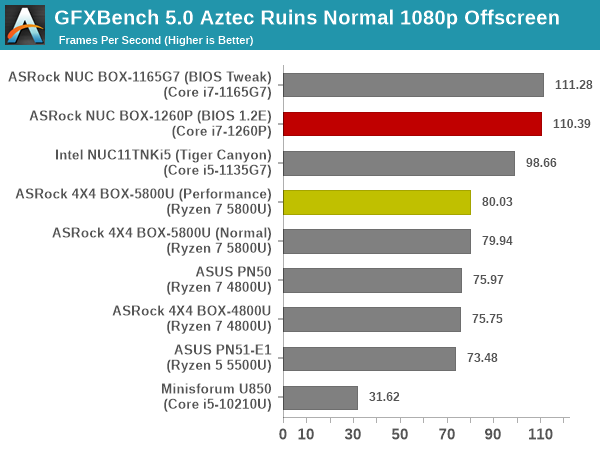
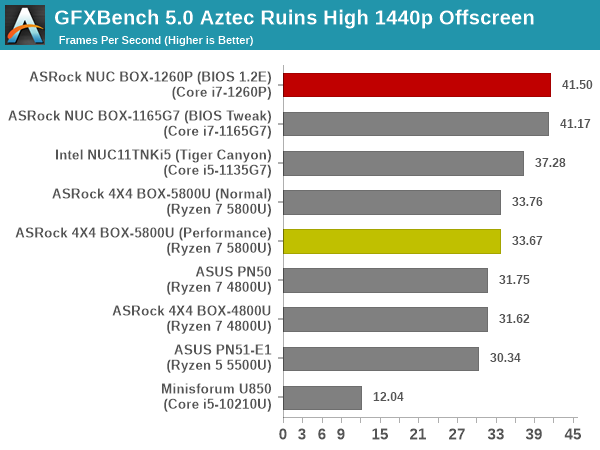
As expected, the reworked architecture from Intel handily bests the AMD offering, delivering around 20% to 30% better numbers.
UL 3DMark
Four different workload sets were processed in 3DMark - Fire Strike, Time Spy, Night Raid, and Wild Life.
3DMark Fire Strike
The Fire Strike benchmark has three workloads. The base version is meant for high-performance gaming PCs. It uses DirectX 11 (feature level 11) to render frames at 1920 x 1080. The Extreme version targets 1440p gaming requirements, while the Ultra version targets 4K gaming system, and renders at 3840 x 2160. The graph below presents the overall score for the Fire Strike Extreme and Fire Strike Ultra benchmark across all the systems that are being compared.
| UL 3DMark - Fire Strike Workloads | |||

The NUC BOX-1165G7 has a higher power budget compared to the NUC BOX-1260P. Since the GPU configurations are the same, the former comes out ahead of the Alder Lake-P system.
3DMark Time Spy
The Time Spy workload has two levels with different complexities. Both use DirectX 12 (feature level 11). However, the plain version targets high-performance gaming PCs with a 2560 x 1440 render resolution, while the Extreme version renders at 3840 x 2160 resolution. The graphs below present both numbers for all the systems that are being compared in this review.
| UL 3DMark - Time Spy Workloads | |||
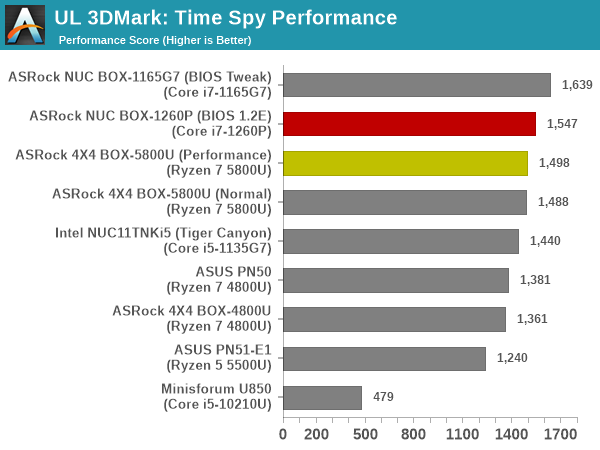
The Cezanne iGPU is able to put up a much better fight in Time Spy, and delivers performance that is almost equivalent to the Intel Iris Xe Graphics in this workload. The TGL-U system with the higher power budget continues to remain on top.
3DMark Wild Life
The Wild Life workload was initially introduced as a cross-platform GPU benchmark in 2020. It renders at a 2560 x 1440 resolution using Vulkan 1.1 APIs on Windows. It is a relatively short-running test, reflective of mobile GPU usage. In mid-2021, UL released the Wild Life Extreme workload that was a more demanding version that renders at 3840 x 2160 and runs for a much longer duration reflective of typical desktop gaming usage.
| UL 3DMark - Wild Life Workloads | |||
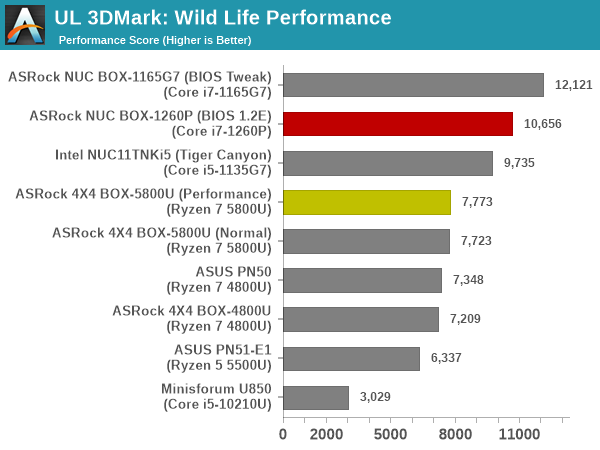
This workload sees the Ryzen iGPU slip down again, with the leaderboard seeing the TGL-U system followed by Alder Lake-P. This is primarily dictated by the power budget.
3DMark Night Raid
The Night Raid workload is a DirectX 12 benchmark test. It is less demanding than Time Spy, and is optimized for integrated graphics. The graph below presents the overall score in this workload for different system configurations.
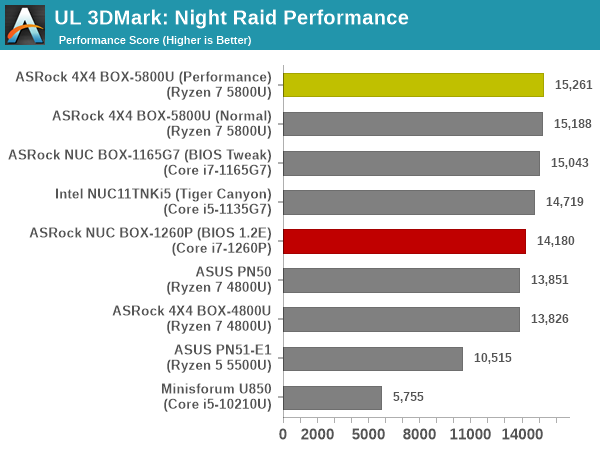
The Ryzen iGPU fares much better in this workload, and comes out on top despite the NUC BOX-1165G7 and the NUC BOX-1260P having higher power budgets.
Overall, the iGPU in the Alder Lake-P system has a slight edge over the one in Cezanne, but there are certain specific workloads where the Cezanne configuration can flex its muscles to come out on top.











34 Comments
View All Comments
erotomania - Saturday, August 20, 2022 - link
Very nice writing, Ganesh. I enjoyed reading the whole article, and I perhaps most enjoyed the section on storage. I would read more, just sayin'.Oxford Guy - Sunday, August 21, 2022 - link
'Due to the variation in configured power limits for both processors, it is not possible to do a scientific apples-to-apples comparison for each benchmark.'And the differences between the SSDs.
Oxford Guy - Sunday, August 21, 2022 - link
Perhaps I missed it. Where is the decibel-to-performance data, or even a simple noise under tough real-world workload chart?stan_dman - Wednesday, August 24, 2022 - link
Impressive little pc's. I'd be interested how noisy the cooling is. I had an optiplex 7050 with i5-7500t (tdp 35w) gave me a headache with a whiny fan.